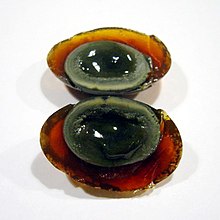
Back بيض القرن Arabic بيض القرن ARZ Стагадовае яйка Byelorussian Вековно яйце Bulgarian শতবর্ষী ডিম Bengali/Bangla Ou centenari Catalan Stoleté vejce Czech Tusindårsæg Danish Tausendjährige Eier German Huevo centenario Spanish
 A century egg sliced open | |
| Alternative names | preserved egg, hundred-year egg, thousand-year egg, thousand-year-old egg, millennium egg, black egg, blacking egg, skin egg, old egg |
|---|---|
| Place of origin | Hunan, China |
| Main ingredients | Egg preserved in clay, ash, salt, quicklime, and rice hulls |
| Variations | duck, chicken, or quail eggs |


| Century egg | |||||||||||||||||||
|---|---|---|---|---|---|---|---|---|---|---|---|---|---|---|---|---|---|---|---|
| Chinese name | |||||||||||||||||||
| Chinese | 皮蛋 | ||||||||||||||||||
| Literal meaning | "leather/skin egg" | ||||||||||||||||||
| |||||||||||||||||||
| Alternative Chinese name | |||||||||||||||||||
| Chinese | 松花蛋 | ||||||||||||||||||
| Literal meaning | pine-patterned egg | ||||||||||||||||||
| |||||||||||||||||||
| Vietnamese name | |||||||||||||||||||
| Vietnamese alphabet | trứng vịt bắc thảo / trứng bách thảo | ||||||||||||||||||
| Hán-Nôm | 𠨡鴨北草 / 𠨡百草 | ||||||||||||||||||
| Literal meaning | northern grass duck egg / hundred-herb egg | ||||||||||||||||||
| Thai name | |||||||||||||||||||
| Thai | ไข่เยี่ยวม้า [kʰàj jîa̯w máː] | ||||||||||||||||||
| RTGS | khai yiao ma | ||||||||||||||||||
| Korean name | |||||||||||||||||||
| Hangul | 피단 | ||||||||||||||||||
| Hanja | 皮蛋 | ||||||||||||||||||
| |||||||||||||||||||
| Japanese name | |||||||||||||||||||
| Kanji | 皮蛋 | ||||||||||||||||||
| Kana | ピータン | ||||||||||||||||||
| |||||||||||||||||||
| Khmer name | |||||||||||||||||||
| Khmer | ស៊ុតបម្រុងទុក | ||||||||||||||||||
Century eggs (Chinese: 皮蛋; pinyin: pídàn; Jyutping: pei4 daan2), also known as alkalized or preserved egg, are a Chinese egg-based culinary dish made by preserving duck, chicken, or quail eggs in a mixture of clay, ash, salt, quicklime, and rice hulls for several weeks to several months, depending on the processing method.[1]
Through the process, the yolk becomes dark greenish grey in color, with a creamy consistency and strong flavor due to the hydrogen sulfide and ammonia present, while the white becomes dark brown in color, with a translucent jelly-like appearance and salty flavor. The transforming agent in the century egg is an alkaline salt, which gradually raises the pH of the egg to around 9–12, during the curing process.[2] This chemical process breaks down some of the complex, flavorless proteins and fats, which produces a variety of smaller flavorsome compounds.[citation needed]
Some eggs have patterns near the surface of the egg white which are likened to pine branches. These patterned eggs are regarded as having better quality than the normal century eggs and are called Songhua eggs (Chinese: 松花蛋), variously translated as pine flower eggs or pine-patterned eggs.[citation needed]
- ^ Moskvitch, Katia (29 March 2013). "Black eggs and ripe guava lead Taiwan's tech revolution". BBC News. Retrieved 29 March 2013.
- ^ McGee, Harold (2004). On Food and Cooking: The Science and Lore of the Kitchen. Scribner. p. 117. ISBN 978-0-684-80001-1.